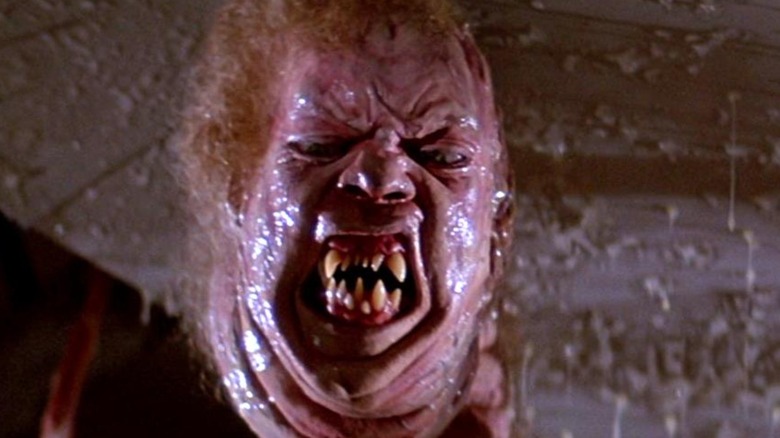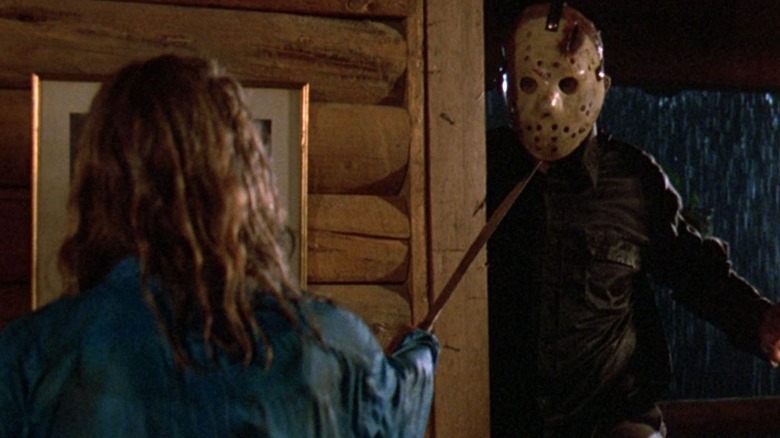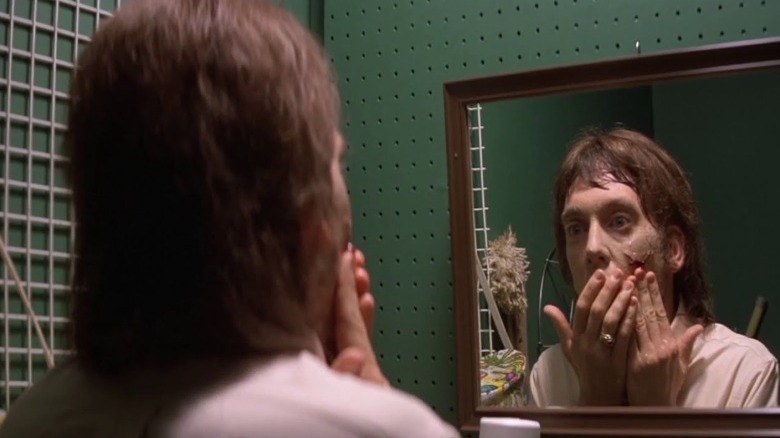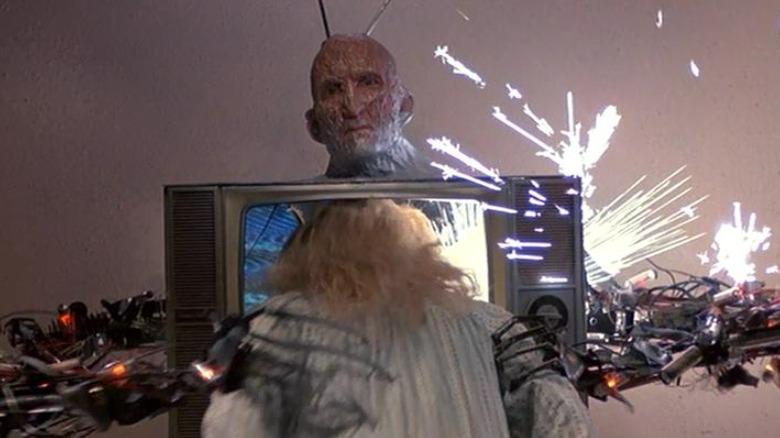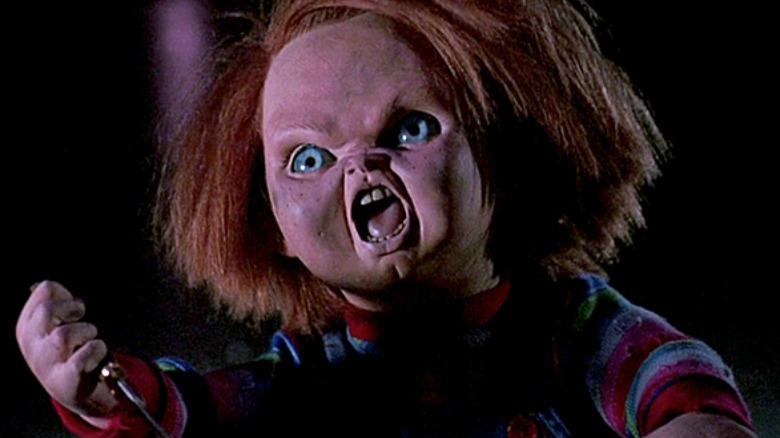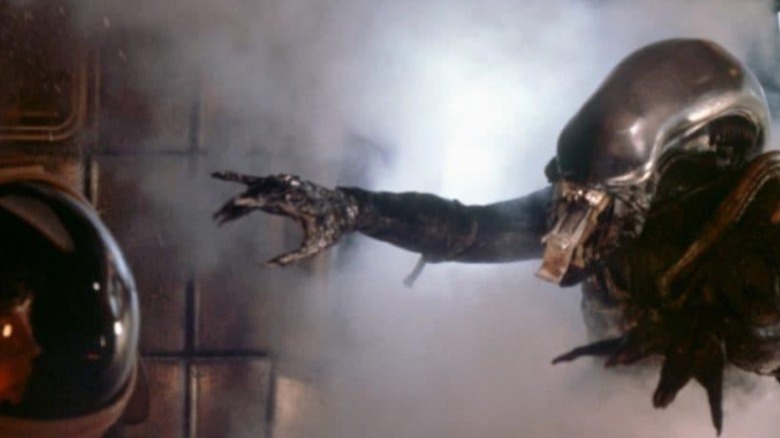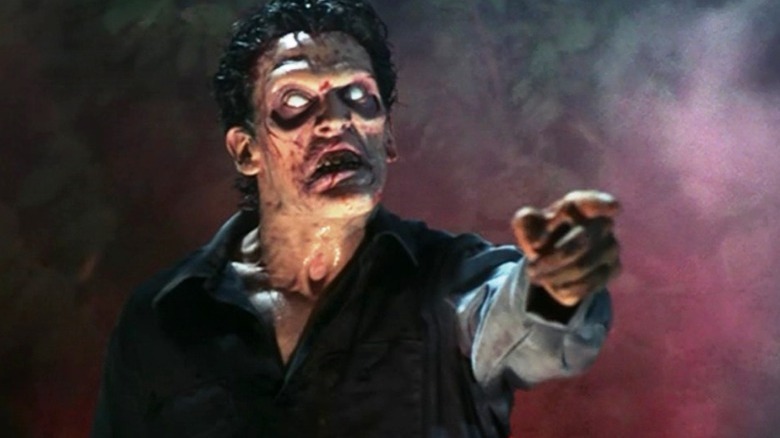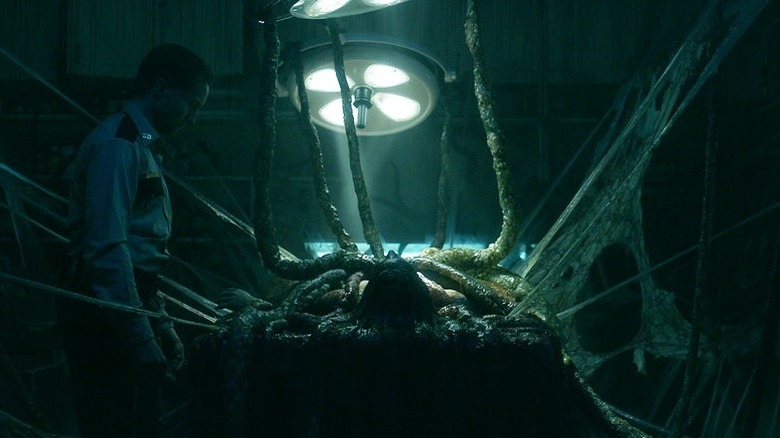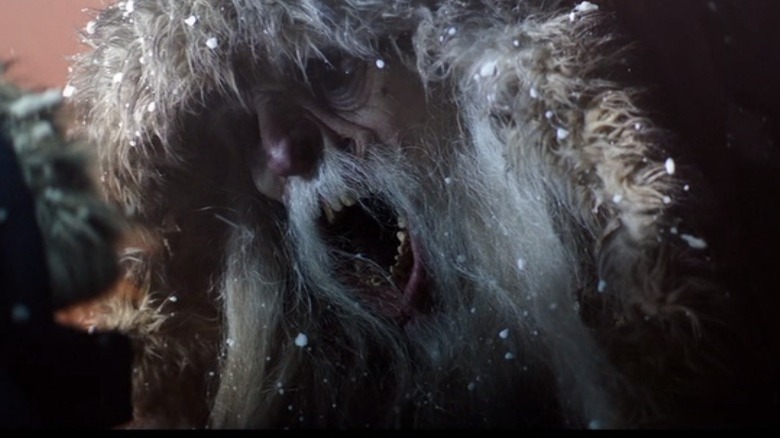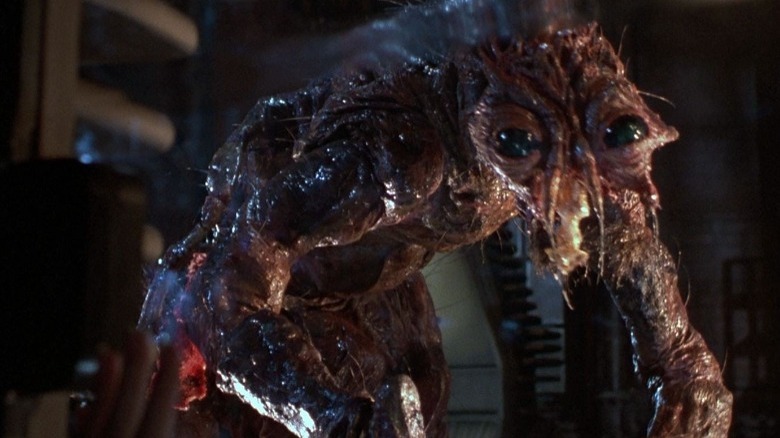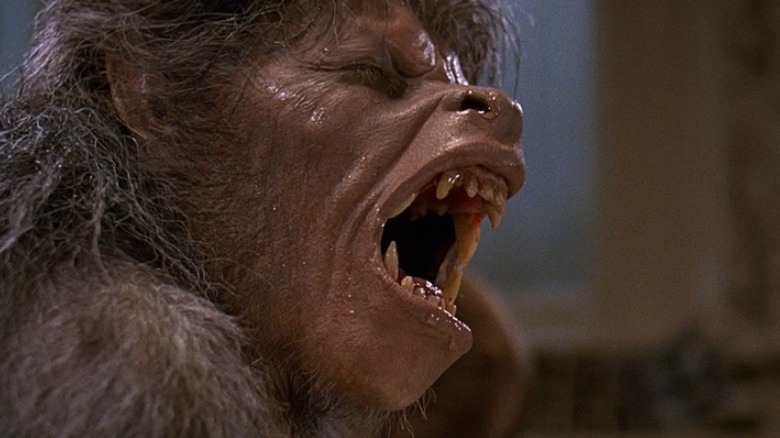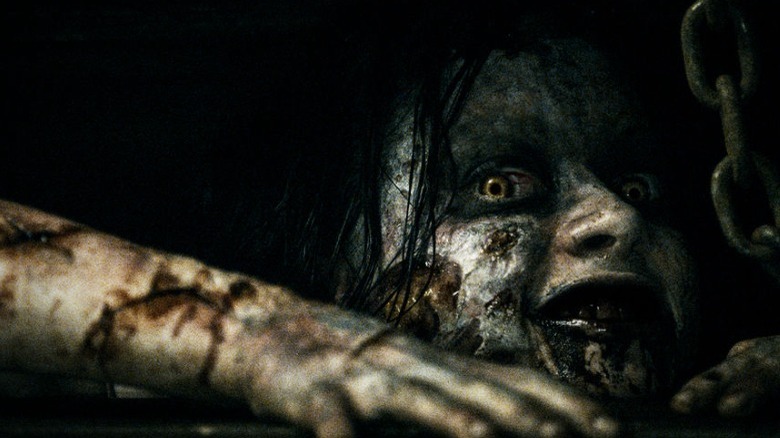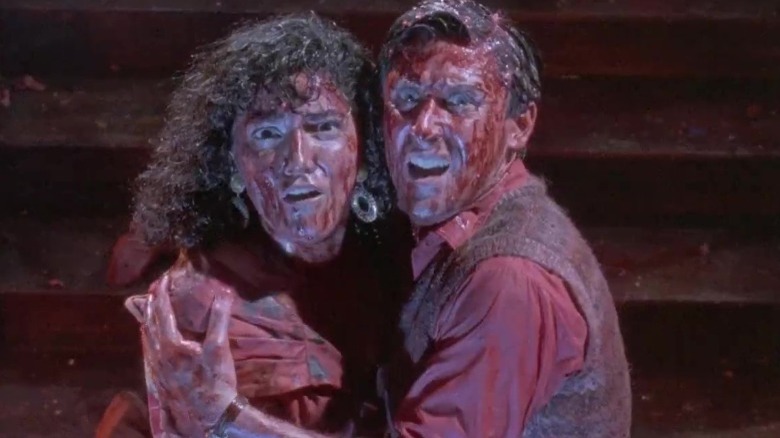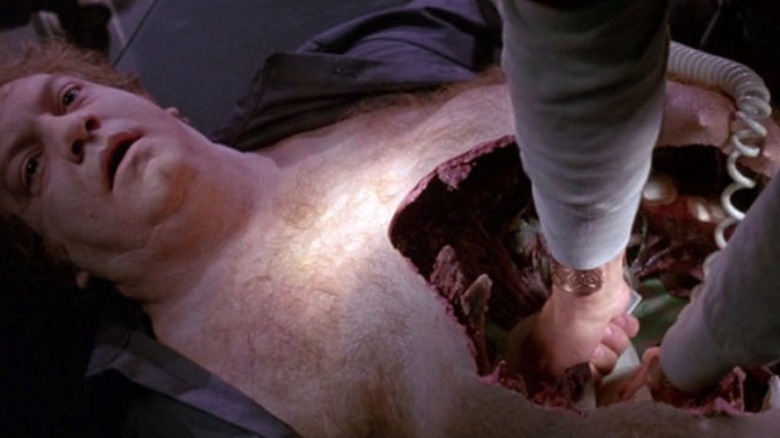The Best Practical Effects In Horror Ranked
The grisly and grotesque are crucial underpinnings of many truly unnerving horror films. In an age where computer animation and effects (CGI) often attempt to get the job done, without proper care such efforts can appear sloppy at best, cold at worst — distancing viewers from the chills and thrills. Which is why many horror aficionados don't approve heavy CGI use, claiming it weakens the most disturbing, frightening aspects of a film's edginess. Some modern films even go as far as to animate simple blood spatter, rendering a cornerstone of the industry awkwardly intangible. This will sometimes weaken the film's performances, as actors covered in goo and surrounded by monsters are more likely to convincingly interact with their environment than someone on a soundstage, staring at a tennis ball on a stick.
Practical effects have been employed in cinema for ages, long before the advent of computer-aided designs. For decades, make-up, puppetry, animatronics, and artificial gore were the only means of creating something truly terrifying. Even now with technology as advanced as it has become, these methods still stand the test of time, offering some of the most realistic and frightening sequences in horror films.
Thankfully, some modern horror filmmakers still maintain the use of practical effects to this day — often wearing it as a badge of pride — with films like "Krampus," "Scary Stories to tell in the Dark," and Andy Muschietti's "It" duology, which used a mixture of CGI and practical effects. Below is a sort of unofficial "hall of fame" for the best practical effects in the horror genre; with any luck, they'll scare Hollywood's gatekeepers into encouraging the filmmakers of tomorrow to keep it real.
13. Friday the 13th: The Final Chapter (1984)
Perhaps the greatest kill ever enacted in the "Friday the 13th" film series took place in the fourth and (not so) final film.
Depicting one of the killer's first deaths ("one of," of course, because audiences would soon learn that Jason Voorhees is an unstoppable, supernatural machine that consistently overpowers any semblance of mortality), it comes at the hands of a young boy. In the final moments of the film, it comes as Jason pursues the remaining survivors, Trish (Kimberly Beck) and her younger brother Tommy (Corey Feldman).
Trish manages to take a swipe at Jason with his own machete, but only manages to knock his mask off, revealing his monstrous visage in all its horrifying glory. For starters, it's difficult to not appreciate the make-up effects at work that turned actor Ted White into the raging, hideous beast Jason Voorhees had become.
But after the killer's mask is removed, the real magic happens. Tommy lunges at the monster, chopping Jason in the skull with the machete. As Jason falls to the floor, the butt of the weapon hits the ground first, causing Jason's face to slide down the blade as his head splits open. It's absolutely grotesque, and oh so satisfying. Horror legend/make-up artist Tom Savini helped create not only the Jason character but the image, returning for this film to aid in the special effects work that produced Jason's gory fate at Tommy's hands.
12. Poltergeist (1982)
Decades later, children of the '80s still harbor fears of ominous-looking trees, creepy clowns and murky swimming pools thanks to the Tobe Hooper-directed, Steven Spielberg-produced (and supposedly, really directed) classic "Poltergeist."
The haunting tale of a family tormented by spirits of the undead, the Freelings made the unfortunate purchase of a home built upon an old graveyard — and now, it's time to pay the price. One key plot point is the family losing their young daughter Carol Anne (Heather O'Rourke) in the chaos of the haunting, whisked away by spirits to another plane. In frantic desperation, the Freelings make every attempt to retrieve the young girl.
At one point in the film, a parapsychologist named Dr. Martha Lesh (Beatrice Straight) brings along her team to give some "expert" advice; one of the crew (played by Martin Casella) experiences a sequence that likely put the real actor in therapy for the rest of his life.
After a long day's work, Lesh's associate Marty looks for a late-night snack. After witnessing his food coming alive and slithering across the counter, he runs to the bathroom, where he begins picking at a facial abrasion in the mirror. Becoming hysterical, the man begins ripping chunks of flesh off his face, peeling down to the bone like a giant human onion.
Although the sequence is revealed to be a hallucination by the character, the sequence was no less disturbing for '80s audiences who made the film a cultural phenomenon. Fun fact: The hands that were tearing away chunks of flesh in the mirror belonged to none other than Steven Spielberg himself.
11. A Nightmare on Elm Street 3: Dream Warriors (1987)
Aside from a signature Dokken theme song, the most memorable thing about this Wes Craven classic is its filled-to-the-brim embrace of practical effects depicting Freddy Krueger (Robert Englund) tormenting teens at a mental health hospital.
The "keep it real" aesthetic is particularly effective here because of the nature of the franchise, which has Freddy using victims' dreams against them. Because of this, anything goes, and a dream can be quickly twisted into a nightmare. It's a realm where Freddy has all the power — unless the so-called "dream warriors" can learn to use its limitless laws of nature for their own defense.
A psychiatric patient in this third Freddy film falls prey to her own slumber. Her name is Jennifer (Penelope Sudrow), and she dreams of someday becoming a TV actress. After falling asleep, she thinks she's watching a talk show with Dick Cavett interviewing Zsa Zsa Gabor — but as the television goes haywire and she steps closer to investigate, Freddy strikes. A pair of arms made of metal circuitry protrude from the box, grabbing Jennifer and picking her up off the floor. Freddy's head then emerges from the top of the television, offering a taunting goodbye.
"This is it, Jennifer. Your big break in TV," he cackles. "Welcome to primetime, b*tch."
Jennifer's head is subsequently rammed through the television, killing her instantly. It would become one of Freddy's most creative and memorable stalking sequences, and looking back years later it's a great example of how practical effects, because they can be clunky and off-putting, can make a scene that much more squirm-inducing.
10. Child's Play (1988)
In terms of sheer creepiness, few things can approach a sinister plaything — transformed from an object of love, joy and laughter for children into something evil, terrifying and malevolent.
Horror maestros have understood this for decades, from 1975's "Trilogy of Terror" Zuni doll to the "Annabelle" films, Billy the puppet from the "Saw" franchise or even Slappy from "Goosebumps." Arguably the most iconic evil doll, however, is Don Macini's Chucky.
Beginning his murderous spree in a series of "Child's Play" slasher films, decades later Chucky has proven himself far more adept at reinvention than many of his knife-wielding contemporaries. Over the years audiences have reimagined their expectations via 1998's "Bride of Chucky," 2004's "Seed of Chucky" and most recently, a hit TV series. While Mancini didn't create the idea of a sinister doll, he definitely popularized it.
While there are moments in "Child's Play" and its sequels that have great practical effects, none is more impressive than Chucky himself. Over the years, the animatronic doll has been infused with tremendous character via a team effort — as evil facial expressions, puppetry, the wicked cackle of actor Brad Dourif and even shots of small actors in costume (running around a set build to be 33 percent larger than normal) are blended together to make movie magic.
With several puppeteers controlling different aspects of the doll, mixed with Ed Gale in costume and creative uses of shadow and light, Chucky has returned to kill again and again. Almost always, this playtime has been practical.
9. Alien (1979)
A new level of terror was achieved when director Ridley Scott brought audiences into the claustrophobic isolation of a spacecraft in deep space, with a vicious predator lurking in the shadows. While the term "predator" would eventually come to be more closely associated with another famous movie alien, it aptly describes the terrifying creature we've come to call the Xenomorph.
After a crew (including "Alien" series heroine Ellen Ripley, rendered iconic by Sigourney Weaver) embarks on a trek aboard a commercial space tug called the Nostromo, they find themselves chasing a mysterious transmission. After locating a creepy, derelict ship, one of them is impregnated with an alien embryo — and then the fun begins.
Decades before Baby Yoda, this young alien creature was decidedly less huggable. It violently emerges from its host's chest cavity, scampering off to find a place to hide (and mature) aboard the Nostromo. As the crew hunts for the creature, it begins picking them off one by one.
In 1979, CGI effects were in their infancy, so practical methods were the only way to portray the horrors and monstrosities of deep space. The Xenomorph was a giant suit, albeit one impressively rendered from the designs of H.R. Giger. Along with other effects artists, Giger crafted a beast with many points of articulation, including a second retractable jaw. The results became a legendary piece of Hollywood magic that would endure through countless books, film sequels, comics, and video games.
8. Evil Dead 2 (1987)
Nothing screams "cult classic" quite like Sam Raimi's "Evil Dead" franchise. The second film in the series evolved from simple horror to darker black comedy, creating a formula that would impact countless films in the decade to come.
Dubbed "splatstick," this "Evil Dead 2" aesthetic proved to be the perfect tone for the film, which sees the hero Ash Williams (Bruce Campbell) tormented by an evil demonic force. If that doesn't sound funny to you, just wait. Ash's hand becomes corrupted and attacks him in a twisted game of "stop of hitting yourself," a mounted deer head taunts the goofy one-liner spewing hero, and there are numerous other creepy, cackling-good moments. The film is overflowing with blood, gore and special effects make-up for the demonically possessed.
In one memorable scene, a decapitated corpse assaults Ash with a chainsaw. The detailed props used to create the grisly assailant effectively calibrates off-the-wall expectations for the level of monstrosities Ash will soon encounter. To get the shot, Ted Raimi (the director's younger brother) wore a full-body latex suit to embody the demonic realization of the historian's wife, Henrietta, who is locked in the cellar. Raimi would later reprise his role as Henrietta in the Starz series "Ash vs. Evil Dead," donning the hefty deadite suit once again. She's absolutely hideous and her ramblings will make your skin crawl, but she is wildly iconic to the franchise at large. The popularity of "Evil Dead 2" among horror fans and its enduring legacy have helped the franchise achieve immortality.
7. The Void (2016)
The 2016 horror film "The Void" invoked themes of H.P. Lovecraft while splashing buckets of blood and gore across the screen. Suffice it to say, the floors of that set must have required a lot of clean-up.
The film follows a group of people at a nearly-empty hospital, where strange occurrences begin unfolding at the behest of a local cult. One of the nurses seemingly loses her marbles, killing a patient before being offed herself by the sheriff. She later turns into a tentacle monster that assaults others within the hospital. Meanwhile, the cult is surrounding the building and the remaining sane folks can't seem to escape. The mystery is deepening as deaths abound and otherworldly creatures emerge.
The film's gore and creature effects are entirely practical. Many of the monsters were modular suits that crew members would wear and puppet. The gore and the effects were the designs of Steven Kostanski, one of the co-directors of the film, who sought to create some of the most visually graphic scenery on set. He even provided much of the make-up effects work for the indie film. Copious amounts of latex went into creating the tentacles that frequently burst onto the scene violently, as well as the monster masks and designs worn by actors. Admirably, it's a modern film that performed the dirty work of an '80s horror movie, and it managed to pay off with stellar, brilliantly disturbing visuals.
6. Krampus (2015)
Let's add a dash of Halloween to our festive Christmas season, as we witness the horror that ensues when you make Santa's naughty list. No, he's not going to bring a lump of coal. Instead, his demonic counterpart, Krampus, may come to enact unspeakable horrors upon you before whisking you away to the depths of hell.
That's the game writer/director Michael Dougherty is playing with his cast of characters in "Krampus," inspired by a pagan Germanic folktale that scares children into behaving. This film visualizes an obnoxious family who loses the spirit of Christmas — and the Krampus who arrives as a result.
The Krampus demon has a wide variety of vicious toys, trinkets, and pastries that hail from the darkest corners of the underworld. These twisted beings include a rabid teddy bear, a child-devouring jack-in-the-box, murderous angels and demonic imps. They're all realized in Dougherty's film through practical effects. In fact, the only creatures in the entire film that are CGI-animated are the mischievous gingerbread men. Everything else is a painstaking creation of the famous Weta Workshop studio.
Whether puppets or costumes, each remarkable detail-infused character brings horrifying personality to the film. The titular monster was a massive costume designed in full by Dougherty and team. Make no mistake, the horrific monsters of the film are the true stars of this particular production.
5. The Fly (1986)
In one of the best creature features of the '80s, this remake of "The Fly" cast Jeff Goldblum as an ambitious researcher determined to invent a means of teleportation between two pods. But he violates two good rules of thumb regarding any scientific experiment: Don't drink and do science, and don't do said science on yourself.
When Seth drunkenly runs a test, a fly enters the chamber of the opposite pod. At first, it seems like a success, as Seth exits from the other pod; as Seth begins to slowly deteriorate, however, he realizes his matter became inextricably mixed up with that of the fly, and now its genetic make-up has begun overtaking his body.
Throughout the film, Seth's transformation is depicted in several different stages. Heavy make-up effects were applied to give Seth the steady and growing disfiguration his transformation required. By the end of the film, Seth turns into a giant grotesque humanoid fly losing all sense of his own humanity. Eventually, Goldblum's make-up work required five hours a day to create after jumping into a rubber suit. In a later stage of the transformation, the head of Goldblum had to be replicated as a puppet according to Bloody Disgusting. This allowed for strained facial movements as well as an emerging fly tongue from the jaw.
The final stages of the character's shift into an inhuman fly monster involved heavy use of animatronics and puppetry that were managed by at least eight separate crew members. The film earned special effects artists Chris Walas and Stephan Dupuis an Academy Award for Best Makeup. Watching Seth's descent into madness and transformation into a monster is harrowing, disturbing, and gruesomely horrific.
4. An American Werewolf in London (1981)
Ask any fan of the horror genre where you can find the best werewolf transformation sequence, and they will inevitably invoke the 1981 John Landis film "An American Werewolf in London."
Following a pair of American backpackers named David Kessler (David Naughton) and Jack Goodman (Griffin Dunne), as they hike across Yorkshire encountering odd receptions from the locals, they are ambushed in the black of night by a creature who kills Jack. David awakens in a hospital and learns of his friend's death. Throughout the film, his friend appears to him as a ghostly visage, explaining to him that he is about to turn into a werewolf on the next full moon and will slaughter many innocents. David doesn't believe him — but as predicted, he transforms into a werewolf of beastly proportions.
The transformation scene is one of the most iconic moments in horror history. Legendary make-up effects designer Rick Baker won an Academy Award for his work on this film. According to Bloody Disgusting, Baker and crew created several deformed limbs and werewolf heads to use during David's transformation. The scene took months to plan and a full week to shoot. Often, the actor would be positioned sticking out of a hole in the floor, so prop legs could be applied.
As Landis endeavored to depict a transformation both realistic and grisly, it brought vivid detail to the pain experienced by the character. This resulted in an unforgettable moment in horror, greater empathy for the character, and ultimately a moment unlike anything seen before or since.
3. Evil Dead (Reboot) (2013)
In 2013, Fede Álvarez directed a remake/reboot of Sam Raimi's "Evil Dead." While the series of films the property was based on evolved into comedic punches mixed with horror, Álvarez's version of the film was purely set in the horror category, just like Raimi's original film. Ash Williams did not return for this reboot. Instead, the film had a female lead by the name of Mia Allen (Jane Levy). Just as with the original, a group of friends stay in a remote cabin where they open the gates to a horrific demonic force that possesses and torments them.
To honor what fans of the original loved so much about the series, the film employed practical effects for all its gory scenery.
"There's no CGI in the movie. Everything you will see is real, which was really demanding," Álvarez told io9 in 2012. "This was a very long shoot, 70 days of shooting at night. There's a reason people use CGI it's cheaper and faster, I hate that. We researched a lot of magic tricks and illusion tricks."
Those that have seen the film understand the impressive level of gut-churning, wincingly brutal violence and bodily mutilation that fuels it. Knowing it was achieved entirely in front of the camera, it's almost impossible to comprehend.
2. Dead Alive (1992)
In perhaps one of the goriest films to ever be made, "Dead Alive" from Peter Jackson ("The Lord of the Rings trilogy") plays the blood and guts for laughs. The level of absurdity in its bloody imagery is meant to provide a sense of levity by its over-the-top nature. The results are ... well ... you'll never be able to forget it, that's for sure.
The film follows a young man (Timothy Balme) who takes his insufferable mother to the zoo, where she is bitten by a strange creature known as the Sumatran rat-monkey. The woman eventually falls apart and zombifies in a disgusting sequence, but she also infects others who similarly zombify and munch on unsuspecting souls. At one point, the chaos becomes so absurd that baby zombies are ripping through people's faces and an entire pile of gore is reanimating itself to attack the living.
The film obviously employed heavy make-up and practical gore effects. Jackson also utilized stop-motion animation and puppeteering during more wild sequences, like the reanimated gore pile or Lionel's monstrous mother at the end of the film. It's a true delight for lovers of gory practical effects in horror. But be warned, it's also rife with gross, gag-worthy scenes that might affect those with weaker stomachs. In short: don't watch this on a first date.
1. The Thing (1982)
Horror maestro John Carpenter created one of the most intense, anxiety-inducing creature-features of all time with "The Thing," a movie whose power is still every bit as effective to today's viewers. Kurt Russell's R.J. MacReady leads a crew of rag-tag researchers at an American outpost in Antarctica as they are infiltrated by a sinister alien creature. The trick, however, is that this alien is a micro-organism that infects a host and assimilates the body. Once the alien has control of a living being, it can warp and mutate, twisting the flesh at will into heinous monstrosities. Some of the most intense sequences in the film involve the crew distrusting each other as they attempt to figure out which one is the alien.
One of the most memorable scenes occurs when a doctor attempts to defibrillate a man who has been rendered unconscious. As he pushes the defibrillator down, the man's chest cavity bursts opens into a huge gaping mouth, as sharp teeth bite the arms off of the good doctor. According to Bloody-Disgusting's in-depth look at the effects of the film, the man on the table was a replica of the actor, constructed via a fiber glass dummy; the effects team then employed hydraulics for the chest cavity mouth that clamps down on the doctor.
The entire shot took nearly half a day to prepare, but it was so worth it. Rubber foam and latex were utilized for the twisting flesh that emerged from the creature as well as gelatin, bubble gum, creamed corn, and other unthinkable oddities. "The Thing" is truly a champion when it comes to the art form that is practical effects.
